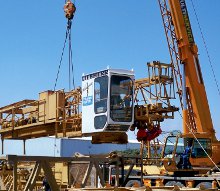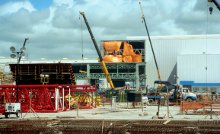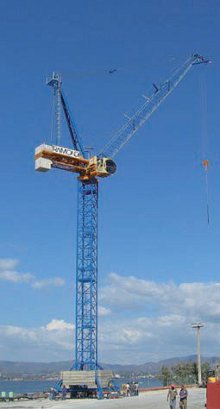From the Andes to the Amazon
22 August 2013The crane market in Latin American has seen a great deal of development in the last few years. As more investors look at tapping into these growing markets Zak Garner-Purkis discusses the current trends in this vast and diverse region.
When you start to examine Latin America, one country immediately stands out: Brazil. As the largest and most populated nation in the region, with a different language to its neighbours, and complex internal regulations, the country is unique. Its crane market has been steadily growing too, as large infrastructure projects have attempted to maintain the construction boom, which started in the commercial and residential sector. Though recent protests have created uncertainties over the future of this economic policy, the nation remains an attractive proposition for anyone in the lifting industry looking for business, particularly those from European nations where work has dried up. Protectionist policies and high levels of bureaucracy are drawbacks, but on the whole this is not putting off those in the lifting industry.
"We have seen strong growth since the early 2000s, probably the best time was 2009 to 2010 but 2011 was good without there being much growth" says Brazilian rental firm Locaben's commercial director Paulo Carvalho, "2012 was warm again without a large increase. For the next year we are expecting a lot of growth, there's no doubt about that because of the Olympics, the World Cup and the related infrastructure projects, such as the Sao Paulo to Rio railway."
"It is too early to say if the protests will cause a big impact in government plans regarding to infrastructure investments. It's clear that people are really upset about politicians and corruption. The rebuild of Brasilia stadium for example cost BRL1.6bn when we have a big lack of schools, universities, public transportation and hospitals: The quality of the health system and public transportation are very poor here. People are claiming for a new politics structure: Brazil has an extremely expensive cost to maintain congress member and senators -- A very inefficient structure. The result of all this movement is unpredictable, but I really believe that are some big changes coming."
In response to the protests the Brazilian government announced that it would spend BRL50bn on public transport projects as well as setting up a National Public Transport Council to make sure the projects pleased commuters and investors alike.
Potential in Latin America isn't just limited to Brazil, there are plenty of other countries that appeal to investors in the crane industry for different reasons. Chile, located on the other side of the continent, has a different approach to its South American neighbour and is attracting outside investment with clear governmental regulations that encourage a free market.
Horst Nickel Hecht, managing director of Chilean crane dealer and hire firm Transvertal, believes that the policies which have been pursued by Chile for many years are now proving a success in several neighbouring countries "In Latin America, in my opinion, there are three countries where there will be a lot of growth: Chile, Peru and Colombia. You can forget the others. The reason why these countries are succeeding, and will succeed, is because the rules are very clear, unlike other nations in the region.
"Chile is a gateway into the region, I would say that it's the first port of call, followed by Peru, and then Colombia. These countries have clear rules and steady work, there might be a single project in Bolivia for a large company to perform but not sustained activity."
"Chile, Peru and Colombia have really free markets, where you can move newer cranes in easily to do the work required. Some sectors in the region stipulate that machinery must be new enough to carry out the work required. For example, in the mining sector no crane over eight-years-old is allowed. Peru and Colombia are just starting out, in these countries you are still able to use older equipment."
Agree to disagree
Currently, Brazil is attracting numerous crane manufacturers and large hire firms. The protectionist laws that stop the market being flooded with imported cranes, have led many manufacturers to establish a Brazilian base, to use to launch operations to neighbouring countries.
XCMG are one of a host of foreign company's now that recently opened a new factory in Brazil. The Chinese company will make truck cranes at its facility in Sao Paulo, which it has invested$200m in, the company is targeting sales of 500 units in the Latin American country in the next year. Compatriots Sany Brasil are another company who have set up a base in the region they believe that a distinct advantage of having a factory base in Brazil allows them customise machines according to local requirements,
Raimondi is another company looking to use Brazil as its operatiing base for its activities in the region, as its executive director Ragnar Brigg explains: "There are good opportunities for cranes in Brazil. But this is not just going to happen overnight. The construction industry has yet to undergo changes in terms of how they relate to the use of technology where they have been lagging behind. This is quite noticeable to anyone that visits a construction site here. There is the Mercosul common market, that aims at promoting free trade across Brazil, Argentina, Uruguay, Paraguay, Chile, and so on. This process will be consolidating itself further despite disparate economic situations among these countries. Our presence is gradually being expanded to the region. We well located to do just that."
Deciding which country to do business across the continent from is complex. Mercosur exists as a loose network of trade agreements between countries in Latin America with the aim of promoting a common market free trade between countries in the region. But as Terex Cranes spokesman Agustin Dominguez says, this is no European Economic Area (EEA): "Mercosur is no Europe, there are many difficulties, companies often do business based on geography. Therefore Argentina, Uruguay and Brazil do a fair amount of trade as well as Paraguay, whilst Chile has links with countries to the north of it in Peru, Bolivia and as well as further north in Ecuador and Colombia. Work is often not based on a particular country, but a specific company. Larger companies will be found across many nations. Whilst a lot of smaller business is done between neighbours whilst large firms extend further."
Transvertal's Hecht would go a step further, questioning whether the agreements hold any importance at all when it comes to trade between neighbours "It's a misconception to think that an increase in business between the different Latin American nations relates to trade agreements, it's nothing more than demand. Certain countries have the funds but lack the expertise and other nations provide the workers with the right expertise. Chileans and Peruvians do not necessarily like working together, they do it because they have to. For example, when you are transporting equipment from Chile to Peru by rail and you reach the border, you must transfer all your equipment onto a different set of tracks at significant cost and risk to the equipment. Things don't flow necessarily as they should each country has its own particular structure and way of doing things. Different countries work together out of necessity not through choice, because there is a need for particular skills or machinery."
In opposition to what appeared to be its intentions the Mercosur has actually made countries more wary of each other and led to some nations creating domestic policy that prevents imports from their neighbours. As Agustin Dominguez says, Chile's free trade attitude and dealings with the US limit the extent to which other countries will trade with it: "Chile does a lot of business with the US and is therefore not an official member of the Mercosur, it has fewer import restrictions."
Risk
The recent financial crisis showed everyone who was not aware already of how dangerous big financial gambles could be. In Latin America restrictions on credit and the high cost of leaving equipment unused has meant local businesses have been unable or unwilling to speculate. The traditional lack of available finance has meant that the money for a crane would often be tied to directly to a project, with large investments on equipment being rare.
This has shaped the demand for particular types of cranes and led to a thriving the secondhand market. Terex's Agustin Domiguez explains: "In South America typically we sell a lot of small to mid size rough terrains, all terrains, as well as crawlers up to 600t. It is a complex market with many variations between different the countries. On one hand we have seen low price items do well, but companies from the region also seek high quality equipment. Low price products are typically small 40t or 50t truck cranes."
"I would say that there is no distinction between preference and price. Purchase power is an issue but cranes are increasingly seen as an investment. Higher quality equipment is quite common. However, it is often industry specific and it can be difficult to generalise."
In Brazil, limitations on imported machinery and the secondhand market has meant that some companies have never invested at all in cranes, preferring other methods in construction.
Raimondi's Ragnar Brigg explains: "Brazil is undergoing changes. For example, building at a faster rate is now of greater importance to local companies. Now even those who see themselves as not being ready to embrace new technologies - and expensive ones at that - can see themselves owning a crane in a few years time. Laws, costs of labour, safety issues, financing, and so on, are still undergoing changes. But it's going to be a gradual process, no one should expect changes overnight. We can assist such a change. We see ourselves as a Brazilian company, not as outsiders. But local production alone will not do the job."
In other Latin American countries political and economic instability makes the risks that come with investing in equipment even more severe. Dominguez continues: "In terms of tower cranes I've been told by rental companies even taking into consideration the low wages in the region that using a crane is more profitable. The difficulties come with the economic uncertainties that exist; a crane is a major investment.
"Economics has a huge impact on decision making when it comes to buying cranes in the region. For example on a high rise project a company will only purchase a crane when it is completely necessary and even then the cost of it will be tied to the project itself. Construction is a unstable market and therefore companies don't want to be left stranded with equipment they won't be able to put to use."
"In a country such as Argentina where there is a recent history of economic turbulence a business is wary about buying a piece of equipment that may have significantly reduced demand in six months time. In Chile they don't have the same level of uncertainty, but firms there are also aware of the benefits that come from owning one of these units."
Here lies another crucial difference between Brazil and other nations, alongside the heavy bureaucracy and taxation is a stable structure of government. Brazilian rental firm Locaben's commercial director Paulo Carvalho commercial director explains: "We are different from all other countries in the region, most of these nations have lower taxation, but Brazil has a stable structure, there is a solid judiciary and not the same political uncertainty compared to other countries in the region. Country's such as Venuezula have different barriers to Brazil."
It's a point supported by Horst Nickel "In certain places where there are unstable political situations a project can be derailed by a change, equipment suddenly is confiscated and so on. Its risky outside of Chile, Colombia and Peru, and with the exception of Brazil which I am not an expert on, are risky, that's just my opinion, but there are figures that also back this up."
Work, work, work
Another result of there being a lack of available finance to crane companies looking to invest in new equipment has been an intense emphasis on the need to keep vehicles working. Brazil is fast approaching a crossroads when the one-off infrastructure projects come to an end and new work needs to be found for the cranes involved. With stadiums for next summers World Cup nearing completion the issue of keeping high capacity machinery working is beginning to press, particularly if you consider that these projects have supported a residential and commercial construction sector, which has been underperforming.
It's a concern for those involved in the projects says Paulo Carvalho of Locabens: "The key is what happens to this equipment after these large one off projects have been completed. The 100tm tower cranes used on the World Cup stadiums can be used most residential projects, but the cranes with a heavier tonnage will have to find other applications."
"There has been a slight downturn in the residential and office sector recently so these infrastructure projects have saved the market a little bit. There is still demand but internal problems within certain companies has contributed to a general slowing down of growth."
From a manufacturers' perspective however there are other trends, which are pushing crane use for projects over a more extended period. Sany Brasil is one manufacturer who can see potential in several other markets: "Concerning to crawler cranes there two main trends: Narrow Track technology for windpower market and Heavy Duty Cycle cranes to attend the foundation market. The first one is under development where there are projects to the next 10 years. The second one uses old equipment and to the next 5 years our market will have to renew the fleet because of safety regulations. Truck cranes have seen a good recent trend in the 70-80t catagory with all four axles steered, like all terrain models, because it decreases the importation rates and automatically end user prices because of Brazilian custom rules."
Quite how the markets in this region will develop is open for debate, it's hard to predict how the crane sector will fair in a geography that has a history of rapid change. But it's a risk that many crane companies from outside the region seem willing to take, key to their success will be understanding the markets they're entering. From a distance its easy to group countries together in this region but on closer examination it soon becomes clear that there are vast differences from place to place, understanding these semantics will ultimately define an outsiders success in the region.
Branching out
It isn't only about crane companies going to Latin America, now the trend is occurring the other way and businesses from the region are heading to Europe and America amongst other places to buy cranes. Particularly in those countries where used equipment is important, as crane fleets are thinned down due to a lack of projects in Europe, for example, this presents an opportunity for a Latin American firm looking to pick up a high quality piece of used equipment. A recent Ritchie Brothers auction in Ocana in Spain drew numerous companies from Latin America from together they made a total of 44 registered bidders.
In the US, relationships with those from the south of the continent are something those in the lifting industry are keen to foster. The Las Vegas crane convention CONEXPO-CON/AGG, had international attendance of 24% in 2011 with Mexico and Brazil were among the top 5 for registered attendance. Its organisers are keen to stress that the Latin America region is a major priority for next years event.



